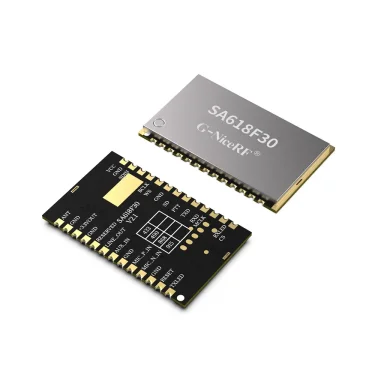Interpretation of special terms for wireless module
In the field of wireless communication, we often encounter specific terms for the performance parameters of wireless modules. Friends who are new to the industry sometimes find these terms more difficult to understand. Therefore, this article will introduce some commonly used professional terms for the performance parameters of wireless modules. Nouns, I hope to help you understand the meaning of these special nouns.
- "Receiving sensitivity" refers to the typical value at a certain data rate. Using an unused rate will have a certain impact on the receiving sensitivity, and it is usually expressed in dBm, which is a level unit.
- "Transmission distance" refers to the transmission distance in an open environment.
- "Antenna gain" refers to the ratio of the power density of the signal generated by the actual antenna and the ideal radiating unit at the same point in space when the power is equal.
- The "Standing Wave Ratio" reflects the matching situation of the antenna feeder system. It measures the performance of the antenna by the ratio of the energy emitted and reflected when the antenna is used as a transmitting antenna. The standing wave ratio is determined by the impedance of the antenna feed system. The impedance of the antenna and the impedance of the feeder are consistent with the impedance of the receiver, and the standing wave ratio is small. For antenna feeder systems with high standing wave ratio, the signal loss in the feeder is great.
- "Radio frequency power" generally refers to the arithmetic average power of the signal output to the load in a specific radio frequency cycle at the frequency studied in the radio station, instrument radio frequency level and antenna system, hereinafter referred to as power. Divided into peak envelope power, average power, carrier power, etc. Traditionally, it is represented by P. The linear units of power usually include W, mW, and μW, and the corresponding level units are dBW, dBmW (usually denoted as dBm), and dBμW.
Conversion relationship of RF power level units dBW, dBm, dBmV, dBμV
When it is necessary to express a power (or voltage) in the system, it can be expressed by level. The level of a certain point in the system refers to the decibel ratio of the power (or voltage) at that point to a certain reference power (or voltage).
10 lg( P / P0) = 20 lg( U / U0)
If 1mW is used as the reference power, the corresponding level when the power is P is 10lg (P/1mW), and the unit is recorded as dBmW (decibel milliwatt). For example, when the power is 1W, the level is 30dBm; when the power is 1mW, the level is 0dBm.
The above are the specific terms of wireless module parameters that are often encountered in the field of wireless communication. This article only lists a small part. When reading the performance parameters of the product specification, if you encounter specific terms that you don’t understand, welcome Customers come to consult us @ sales@nicerf.com.
 +86-755-23080616
+86-755-23080616
 sales@nicerf.com
sales@nicerf.com
Website: https://www.nicerf.com/
Address: 309-314, 3/F, Bldg A, Hongdu business building, Zone 43, Baoan Dist, Shenzhen, China




